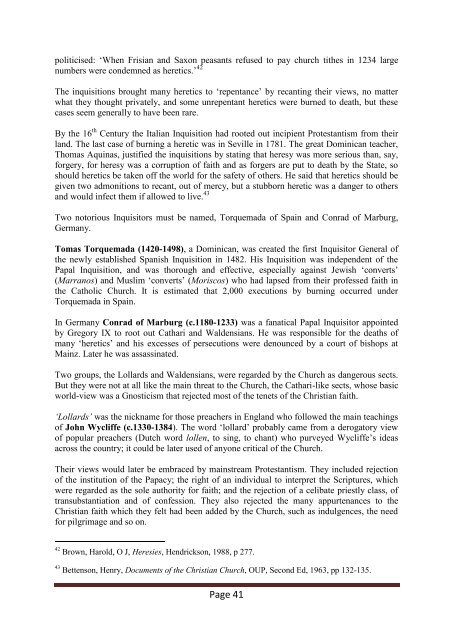Digging Out the Embedded Church - The Maranatha Community
Digging Out the Embedded Church - The Maranatha Community
Digging Out the Embedded Church - The Maranatha Community
Create successful ePaper yourself
Turn your PDF publications into a flip-book with our unique Google optimized e-Paper software.
politicised: „When Frisian and Saxon peasants refused to pay church ti<strong>the</strong>s in 1234 large<br />
numbers were condemned as heretics.‟ 42<br />
<strong>The</strong> inquisitions brought many heretics to „repentance‟ by recanting <strong>the</strong>ir views, no matter<br />
what <strong>the</strong>y thought privately, and some unrepentant heretics were burned to death, but <strong>the</strong>se<br />
cases seem generally to have been rare.<br />
By <strong>the</strong> 16 th Century <strong>the</strong> Italian Inquisition had rooted out incipient Protestantism from <strong>the</strong>ir<br />
land. <strong>The</strong> last case of burning a heretic was in Seville in 1781. <strong>The</strong> great Dominican teacher,<br />
Thomas Aquinas, justified <strong>the</strong> inquisitions by stating that heresy was more serious than, say,<br />
forgery, for heresy was a corruption of faith and as forgers are put to death by <strong>the</strong> State, so<br />
should heretics be taken off <strong>the</strong> world for <strong>the</strong> safety of o<strong>the</strong>rs. He said that heretics should be<br />
given two admonitions to recant, out of mercy, but a stubborn heretic was a danger to o<strong>the</strong>rs<br />
and would infect <strong>the</strong>m if allowed to live. 43<br />
Two notorious Inquisitors must be named, Torquemada of Spain and Conrad of Marburg,<br />
Germany.<br />
Tomas Torquemada (1420-1498), a Dominican, was created <strong>the</strong> first Inquisitor General of<br />
<strong>the</strong> newly established Spanish Inquisition in 1482. His Inquisition was independent of <strong>the</strong><br />
Papal Inquisition, and was thorough and effective, especially against Jewish „converts‟<br />
(Marranos) and Muslim „converts‟ (Moriscos) who had lapsed from <strong>the</strong>ir professed faith in<br />
<strong>the</strong> Catholic <strong>Church</strong>. It is estimated that 2,000 executions by burning occurred under<br />
Torquemada in Spain.<br />
In Germany Conrad of Marburg (c.1180-1233) was a fanatical Papal Inquisitor appointed<br />
by Gregory IX to root out Cathari and Waldensians. He was responsible for <strong>the</strong> deaths of<br />
many „heretics‟ and his excesses of persecutions were denounced by a court of bishops at<br />
Mainz. Later he was assassinated.<br />
Two groups, <strong>the</strong> Lollards and Waldensians, were regarded by <strong>the</strong> <strong>Church</strong> as dangerous sects.<br />
But <strong>the</strong>y were not at all like <strong>the</strong> main threat to <strong>the</strong> <strong>Church</strong>, <strong>the</strong> Cathari-like sects, whose basic<br />
world-view was a Gnosticism that rejected most of <strong>the</strong> tenets of <strong>the</strong> Christian faith.<br />
„Lollards‟ was <strong>the</strong> nickname for those preachers in England who followed <strong>the</strong> main teachings<br />
of John Wycliffe (c.1330-1384). <strong>The</strong> word „lollard‟ probably came from a derogatory view<br />
of popular preachers (Dutch word lollen, to sing, to chant) who purveyed Wycliffe‟s ideas<br />
across <strong>the</strong> country; it could be later used of anyone critical of <strong>the</strong> <strong>Church</strong>.<br />
<strong>The</strong>ir views would later be embraced by mainstream Protestantism. <strong>The</strong>y included rejection<br />
of <strong>the</strong> institution of <strong>the</strong> Papacy; <strong>the</strong> right of an individual to interpret <strong>the</strong> Scriptures, which<br />
were regarded as <strong>the</strong> sole authority for faith; and <strong>the</strong> rejection of a celibate priestly class, of<br />
transubstantiation and of confession. <strong>The</strong>y also rejected <strong>the</strong> many appurtenances to <strong>the</strong><br />
Christian faith which <strong>the</strong>y felt had been added by <strong>the</strong> <strong>Church</strong>, such as indulgences, <strong>the</strong> need<br />
for pilgrimage and so on.<br />
42 Brown, Harold, O J, Heresies, Hendrickson, 1988, p 277.<br />
43 Bettenson, Henry, Documents of <strong>the</strong> Christian <strong>Church</strong>, OUP, Second Ed, 1963, pp 132-135.<br />
Page 41








